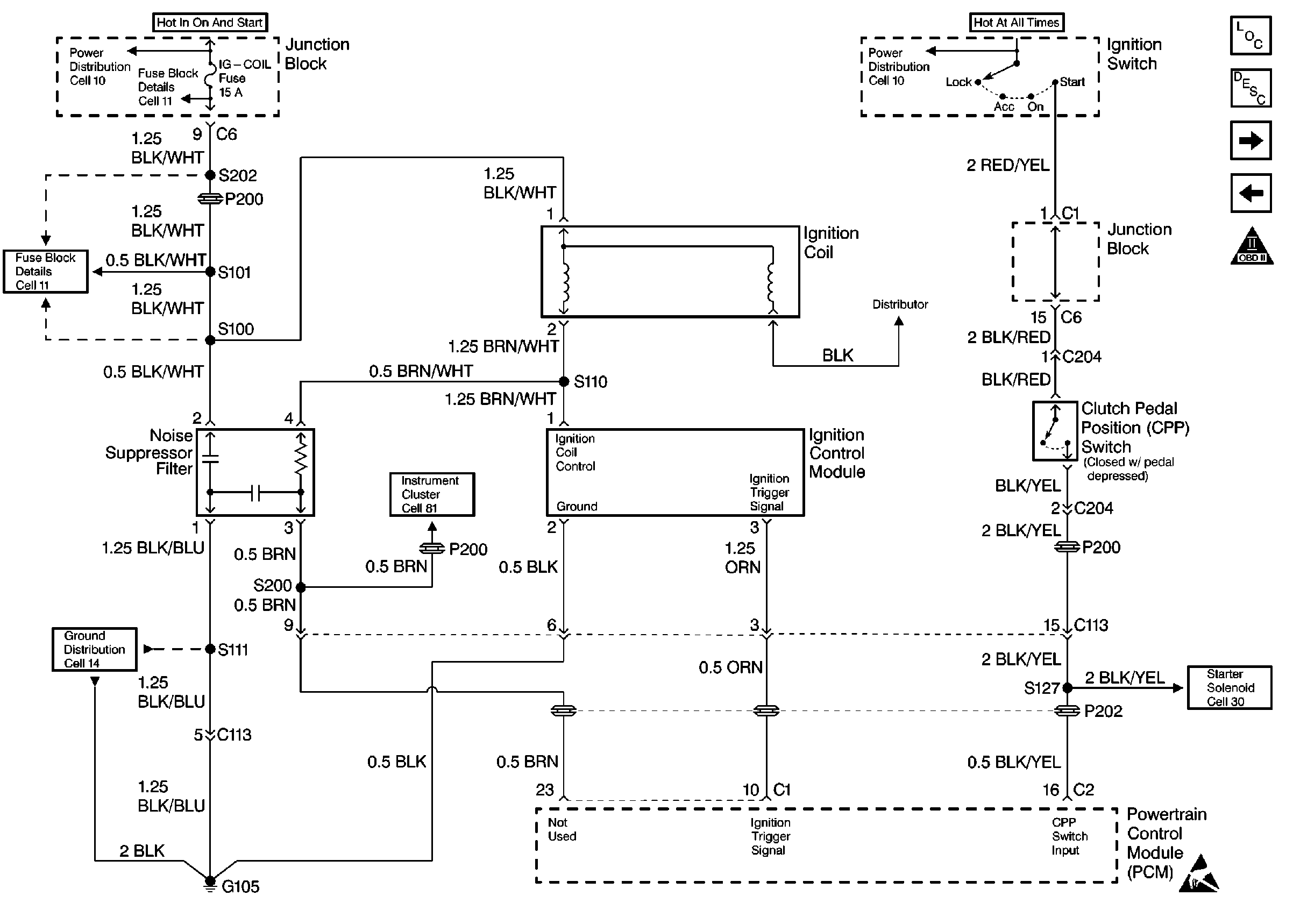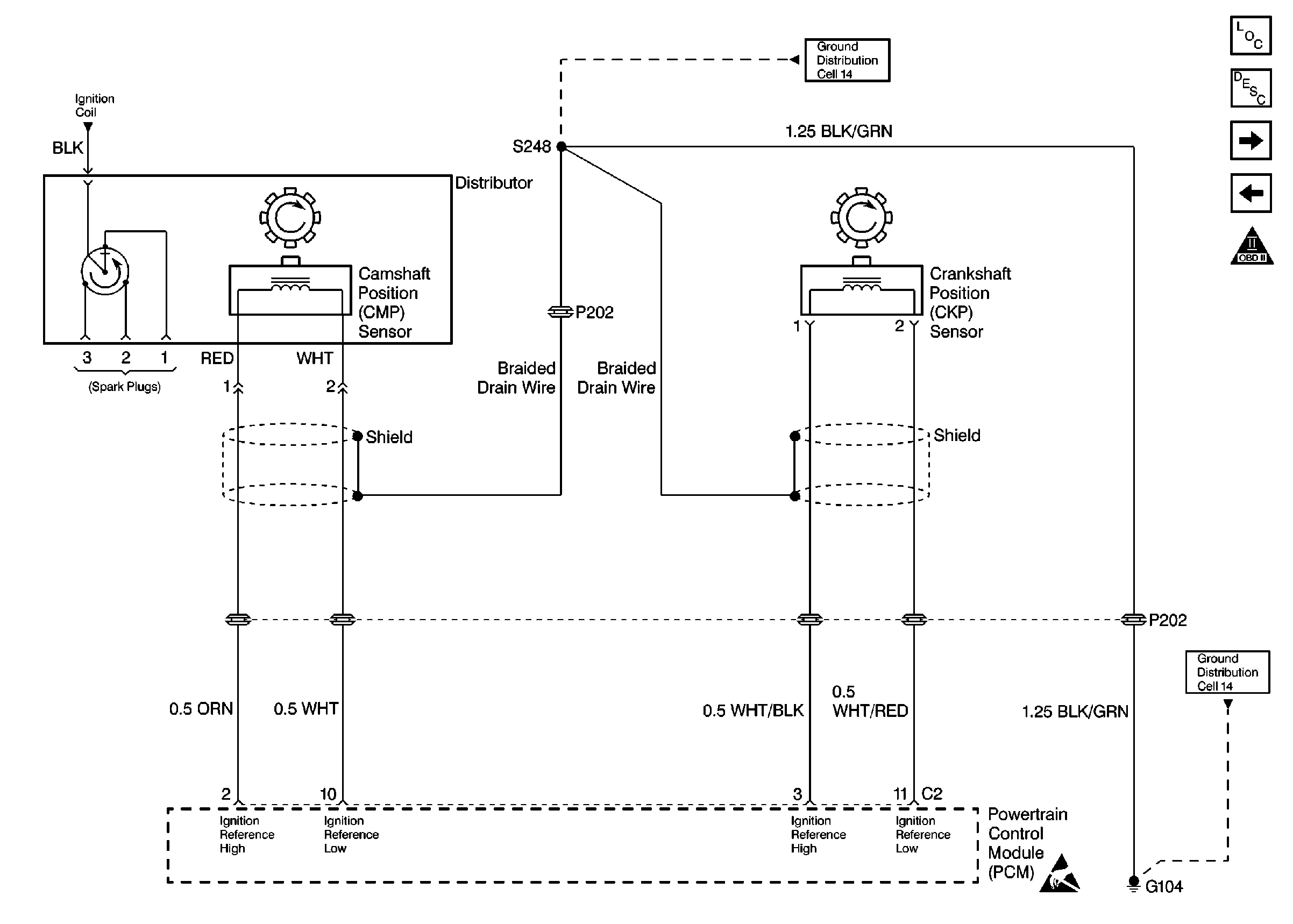Refer to

and

.
Circuit Description
The powertrain control module (PCM) uses information from the crankshaft position (CKP) sensor and the camshaft position (CMP) sensor in order to determine when an engine misfire is occurring. By monitoring changes in the crankshaft rotation for each cylinder the PCM counts individual misfire events. The malfunction indicator lamp (MIL) illuminates when the misfire rate equals or exceeds a pre-determined count. A misfire rate that is high enough can cause the catalytic converter to overheat under certain driving conditions. The MIL will flash On and Off when the conditions for catalytic converter overheating are present.
Conditions for Running the DTC
| • | Engine coolant temperature is -10°C to 110°C (14°F to 230°F). |
| • | Intake air temperature is -10°C to 70°C (14°F to 158°F). |
| • | Barometric pressure is greater than 75 kPa. |
| • | TP sensor change is less than 1.9 degrees/16 firing events. |
| • | The change in MAP is less than 1.3 kPa / 60 firing events. |
| • | Engine speed is less than 6,500 RPM and the change in engine speed is less than 200 / 50 msec. |
Conditions for Setting the DTC
| • | The misfire rate at 200 engine revolutions is greater than a specified value. |
| • | The misfire rate at 1,000 engine revolutions is greater than a specified value. |
| • | The conditions are present for 5 seconds after the engine is started to 1 second from fuel shut-off. |
Action Taken When the DTC Sets
| • | The PCM flashes the malfunction indicator lamp (MIL) the first time a catalyst damaging misfire occurs. |
| • | The PCM illuminates the MIL the second time emission thresholds are exceeded (second time the diagnostic fails). |
| • | The PCM records the operating conditions at the time the diagnostic fails. This information is stored in the Freeze Frame buffer. |
| • | The PCM enters the Fail-Safe Function and stops EGR control. |
Conditions for Clearing the MIL/DTC
| • | The MIL turns OFF after three consecutively passing trips without a fault present. |
| • | A History DTC clears after 40 consecutive warm-up cycles without a fault. |
| • | Use the scan tool Clear DTC Information function or disconnect the PCM battery feed in order to clear the DTC. |
Diagnostic Aids
Check for any of the following conditions:
| • | If any DTCs other than misfire (P0300 to P0303) are present, diagnose those DTCs first. |
| • | Check for engine overheating. |
| • | Check for engine vacuum leaks. |
| • | Improper EGR system operation. Refer to Exhaust Gas Recirculation (EGR) System Diagnosis . |
| • | Check for a PCV system malfunction. Perform a functional check of the PCV valve. Refer to Crankcase Ventilation System Inspection . |
| • | An intermittent ignition system malfunction (spark plugs, ignition wires, ignition coil, and the distributor). Check ignition system performance with an engine oscilloscope. |
| • | Fuel pressure that is out of specification or a malfunctioning fuel injector. Refer to Fuel System Diagnosis . |
| • | Check for contaminated fuel. |
| • | Check for the correct viscosity engine oil. The wrong engine oil may cause improper valve lifter operation. |
| • | An engine mechanical malfunction. Measure engine cylinder compression and valve lash adjustment for comparison to manufacture specifications. Refer to Engine Compression Test Engine Mechanical. |
| • | A damaged wiring harness. Inspect the applicable wiring harness for damage and repair as necessary. |
| • | A misfire DTC can also be the result of a defective crankshaft timing belt pulley. Remove the crankshaft position (CKP) sensor and inspect the crankshaft signal rotor through the sensor hole. Check the crankshaft signal rotor for foreign material or damaged teeth. |
If a DTC P0301 cannot be duplicated, the information included in the Freeze Frame data can be useful in determining vehicle operating conditions when the DTC was first set.
An intermittent fault may be duplicated by wetting the secondary ignition system with water and operating the vehicle under the conditions that the DTC set.
Test Description
The numbers below refer to the step numbers in the Diagnostic Table.
-
The Powertrain OBD System Check prompts the technician to complete some basic checks and store the freeze frame data on the scan tool if applicable. This creates an electronic copy of the data taken when the fault occurred. The information is then stored in the scan tool for later reference.
-
This step determines if a fault is present.
-
Additional ignition system components (the noise suppressor filter or the ignition control module) may cause a DTC P0301 to set. For additional information refer to Engine Electrical.
-
Low engine compression and improper valve lash may also cause a rough idling condition. For diagnosis of an engine mechanical concern, refer to Engine Mechanical Diagnosis.
Step | Action | Value(s) | Yes | No | ||||||||||||||||||
|---|---|---|---|---|---|---|---|---|---|---|---|---|---|---|---|---|---|---|---|---|---|---|
Did you perform the Powertrain On-Board Diagnostic System Check? | -- | |||||||||||||||||||||
2 | Start the engine. Is a misfire present at Idle? | -- | ||||||||||||||||||||
Is a DTC P0301 set? | -- | Go to Diagnostic Aids | ||||||||||||||||||||
4 |
Is a blue spark present? | -- | ||||||||||||||||||||
5 |
Did you replace the wire? | -- | ||||||||||||||||||||
6 |
Did the #1 ignition wire need replacement? | 3.0k to 6.7k ohms/ft | ||||||||||||||||||||
7 |
Was a repair necessary? | -- | ||||||||||||||||||||
Was an adjustment or a repair necessary? | 0.2-0.4 mm (0.008-0.016 in.) | |||||||||||||||||||||
9 |
Did the #1 spark plug need replacement? | -- | ||||||||||||||||||||
10 |
Was a repair necessary? | -- | Go to Diagnostic Aids | |||||||||||||||||||
11 | Was the spark plug replaced because of fuel, oil, or coolant fouling? | -- | ||||||||||||||||||||
Was a basic engine mechanical fault found and repaired? | -- | Go to Diagnostic Aids | ||||||||||||||||||||
13 |
Does the scan tool display any DTC? | -- | Go to the Applicable DTC Table | System OK |
